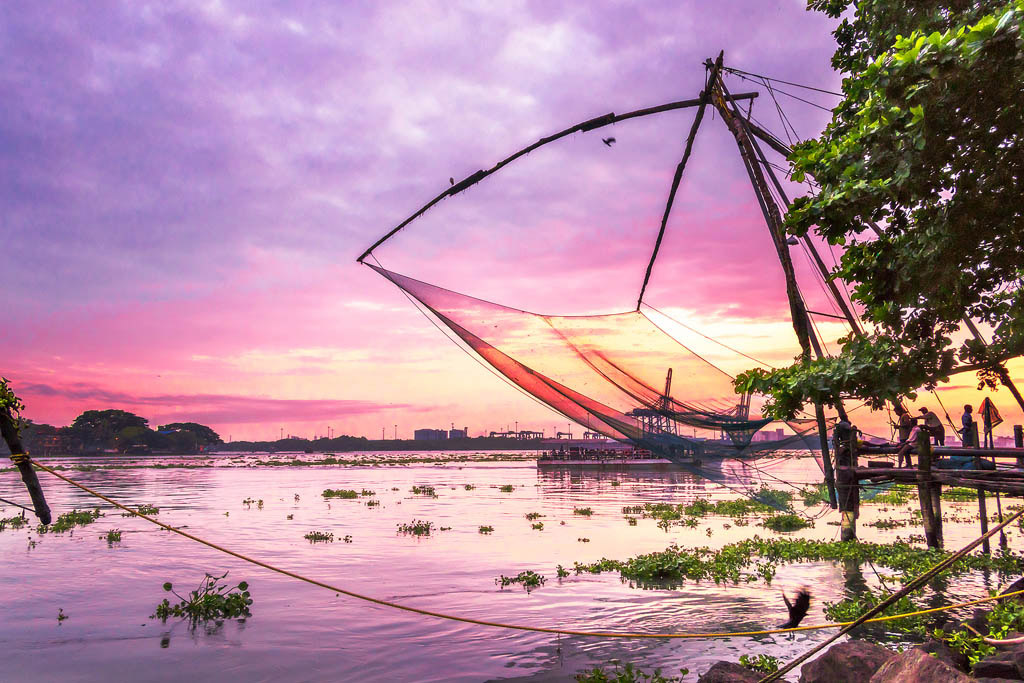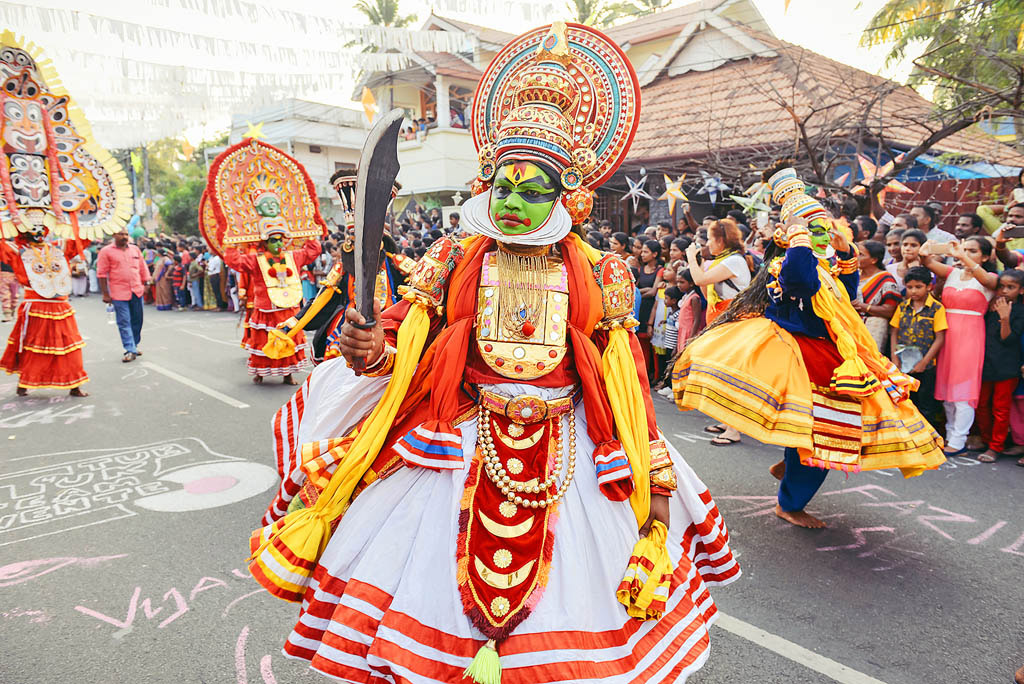Kerala
Serene Kerala is a state shaped by its wonderful natural landscape: a long, luxurious coastline; wandering backwaters; lush palms and spice plantations; and cool, sky-reaching mountainscapes. Add the kaleidoscope of culture best experienced in the unique performing arts and you’ll understand why Kerala is a destination not to be missed.

Beaches
Goa might pull in the beach-holiday crowds, but Kerala’s coastline – almost 600km of it – features a stunning string of golden-sand beaches, fringed by palms and washed by the Arabian Sea. The southern beaches are the most popular, while wilder, less-discovered choices await in the north.
Southern Beaches
The most established of the resorts along Kerala’s southern coast is Kovalam, just a short hop from the capital Thiruvananthapuram (Trivandrum). Once a quiet fishing village, Kovalam has two sheltered crescents of beach perfect for paddling or novice surfing, overlooked by low-rise hotels, ayurvedic centres and restaurants. Some lovely beaches and ayurvedic resorts cluster southeast of Kovalam in less-busy Pulinkudi and Chowara. North of Trivandrum is Varkala, which straggles along dramatic, russet-and-gold-streaked cliffs. Although a holy town popular with Hindu pilgrims, Varkala has also developed into Kerala’s favourite backpacker bolthole and the cliffs are lined with guesthouses, open-front cafes and bars all moving to a reggae, rock and trance soundtrack. Travellers looking for a quieter scene are drifting north to Odayam Beach.
Even further north, Alappuzha (Alleppey) is best known for its backwaters, but also has a pretty coastline stretching up to increasingly popular Marari, with its golden sands and intimate resorts. Just north of Kochi (Cochin) on Vypeen Island lies Cherai Beach, a lovely stretch of dusty-blonde sand, with kilometres of lazy lagoons and backwaters only a few hundred metres inland.

Far North & Islands
Fewer travellers make it to Kerala’s far north, which means there are some deserted pockets of powdery beach, where resorts are replaced by more traditional village life. Among the best are the peaceful gold sands just south of Kannur, or a little further north around the Valiyaparamba backwaters, Nileshwar and Bekal. Kannur’s mellow homestays and Bekal’s luxury hotels add to the appeal.
Even more far flung are Lakshadweep’s islands, a palm-fringed archipelago 300km west of Kerala. As well as pristine bleach-blonde beaches, these islands have some of India’s best scuba diving and snorkelling.

Best Beach Towns
The beautiful cliff-edged coastline of Varkala is an important Hindu holy place as well as a lively backpacker-focused beach hang-out. Great base for yoga, surfing and traveller vibes.
Kovalam is Kerala’s most commercial beach resort, but still fun and easily accessible with good waves, yoga and surfing. Resorts here and further southeast have a strong ayurvedic focus.
The blissfully quiet gold-tinted beaches of Bekal, strung along Kerala’s northernmost coast, are a world away from the busy resorts in the south.
While Kannur itself is not particularly exciting for visitors, head 8km southeast to Thottada for gorgeous beaches and family-owned homestays.
Just north of Alleppey, Marari is growing into a favourite seafront getaway for its honey-coloured beaches and luxury accommodation.

Backwaters
Kerala’s 900km of waterways weave watery tendrils through a lusciously green landscape. Palm-shaded, winding canals are lined by back-in-time villages, many of which are accessible only by boat. It’s an environment unique to Kerala – and an unforgettable South India experience.
Houseboats
To glide along the canals in a punted canoe, or sleep under a firmament of stars in a traditional houseboat, is pure enchantment. The distinctive houseboats that cluster around the main hubs of Alappuzha (Alleppey) and Kollam (Quilon) are designed like traditional rice barges or kettuvallam (‘boats with knots’, so-called because the curvaceous structure is held together by knotted coir).
There are several ways to explore the backwaters. The most popular is to rent a houseboat for a night or two; these sleep anywhere from two to 14 or more people, and vary wildly in luxury and amenities. The hire includes staff (at least a driver and cook, but often additional kitchen staff and crew), so catering is included, and you’ll eat traditional Keralan meals of fish and vegetables cooked in coconut milk. The popularity of these tours can mean that the main waterways get very busy – even gridlocked – in peak season. A one-night houseboat trip won’t get you far through the backwaters.
Talk to returning travellers or guesthouse owners, and search online to gauge costs, quality and recommendations; note that some of the best houseboats get booked up in advance.

Ferries, Canoes & Kayaks
The cheapest means of seeing the waterways is to take a public ferry. You can take trips from town to town, though you won’t travel much of the smaller canals. Two of the most popular trips are the all-day tourist cruise between Kollam and Alleppey, a scenic but slow eight-hour trip, and the 2½-hour ferry (here) from Alleppey to Kottayam.
A better way to venture deep into the network and escape the bigger boats is on a canoe tour (here), which allows you to travel along the narrower canals and see village life in a way that’s impossible on a houseboat or ferry. Village tours with a knowledgeable guide are another tranquil way to explore the region and understand some of the local culture.
Kayaking the canals is gaining popularity; operators such as Kerala Kayaking will take you far into the backwaters where you can paddle through villages.
Ecofriendly Backwaters Tourism
The choice of houseboats – especially at Alleppey’s houseboat dock – is mind-boggling, and your selection of boat and operator can make or break the experience in a variety of ways. Meanwhile, houseboat tourism is taking its toll on the local environment. Look for houseboats that take steps to minimise their environmental impact (such as by using solar panels), and avoid peak season (mid-December to mid-January) and domestic holidays when prices peak and the waterways are clogged. Or consider exploring by punt-powered canoe, kayak or public ferry instead.

Performing Arts
Kerala has an intensely rich culture of performing arts – living art forms are passed on to new generations in specialised schools and arts centres. Many of these arts are performed in tourist destinations.
Kathakali
Kathakali – with its elaborate ritualised gestures, heavy masklike make-up, and dramatic stories of love, lust and power struggles based on the Ramayana, the Mahabharata and the Puranas – stems in part from 2nd-century temple rituals, though its current form developed around the 16th century. The actors tell stories through precise facial expressions and mudras (hand gestures). Traditionally, the male-led performances start in temple grounds at around 8pm and go on all night, though condensed versions for those with shorter attention spans are performed in many tourist centres.

Kalarippayat
Taking its moves from both Kathakali and theyyam is the martial art of kalarippayat, an ancient, ritualistic discipline practised across Kerala. It’s taught and displayed in an arena called a kalari, which combines a gymnasium, school and a temple.

Theyyam
Theyyam is believed to be older than Hinduism, having developed from harvest folk dances. It’s performed in kavus (sacred groves) in northern Kerala. The word refers to the ritual itself, and to the shape of the deity or hero portrayed, of which there are around 450. The costumes are magnificent, with face paint, armour, garlands and huge headdresses. Performances consist of frenzied dancing to a wild drumbeat, creating a trance-like atmosphere, and are primarily religious rituals rather than demonstrations for audiences.

Places to See Performing Arts
The easiest places for travellers to see performances are at cultural centres such as the Kerala Kathakali Centre in Kochi; Mudra Cultural Centre in Kumily; and Punarjani Traditional Village in Munnar. In Kovalam and Varkala there are often short versions of Kathakali shows in season. In spring, numerous festivals offer the chance to see Kathakali, including Kollam’s Pooram festival in April.
If you’re interested in learning more about the art of Kathakali, Kerala Kalamandalam near Thrissur and Margi Kathakali School in Trivandrum offer courses for serious students, or you can attend these schools to see performances and practise sessions. Kochi’s Kerala Kathakali Centre also runs classes.
The Kochi, Munnar and Kumily centres have demonstrations of kalarippayat, or you can visit the martial art training centres of CVN Kalari Sangham in Trivandrum and Ens Kalari in Nettoor, close to Ernakulam.
The best areas to see theyyam performances are around Kannur, Payyanur and Valiyaparamba, in the northern backwaters area, where there are more than 500 kavus. The season is from October to May. For advice on finding performances, contact the Tourist Desk in Kochi or homestays at Thottada Beach, especially Costa Malabari.
Hill Stations & Sanctuaries
Extending through the World Heritage–listed Western Ghats, Kerala’s hill country is a sumptuous natural spectacle of narrow roads meandering up through thick jungle vegetation and providing dizzying views over peacock-green tea plantations. A cooling altitude makes its upland towns soothing places to escape from the sultry coast, while wildlife sanctuaries here are largely unspoilt wildernesses offering the chance to spot wild animals and birdlife.

Munnar
Best known of Kerala’s hill stations is Munnar, with contoured green tea fields and plantations carpeting the hills as far as the eye can see. This is South India’s tea-growing heartland, but also a great place to trek to viewpoints across fine mountain scenery. Some wonderfully remote lodgings are hidden in the hills, tucked deep into spice and flower gardens or cardamom and coffee plantations.
Wayanad & Periyar
The northern area around Wayanad Wildlife Sanctuary has shimmering green paddy fields, peaks rising to 2100m and plantations of coffee, cardamom, ginger and pepper, and its rolling hills are fragrant with wild herbs and punctuated by mammoth clumps of bamboo. This is one of South India’s best places to spot wild elephants, and there’s some good trekking.
At Periyar Tiger Reserve, Kerala’s most-visited wildlife park, you can cruise on Periyar Lake, hang out in the laid-back hill town of Kumily, paddle on a bamboo raft or embark on a jungle trek with a trained tribal guide.